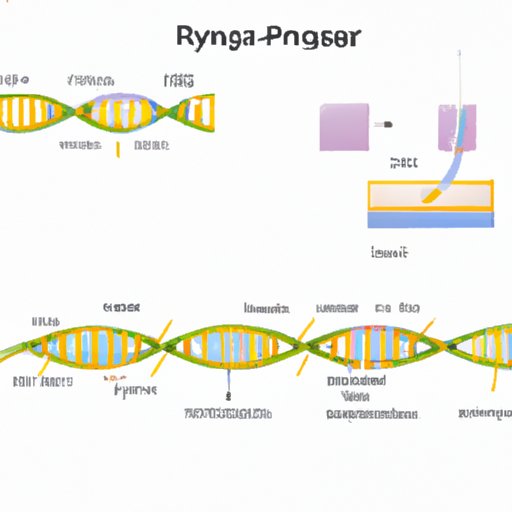Introduction
Transcription is a vital process that occurs within all living cells. It is responsible for the transfer of genetic information from DNA to RNA, which in turn directs the synthesis of proteins. Without transcription, protein synthesis would be impossible, and life as we know it would not exist. In this article, we will explore the step-by-step process of transcription, the science behind it, and its importance in gene expression.
A Step-by-Step Guide to Transcription: What Happens During the Process
Transcription involves several steps, each of which is crucial to ensure an accurate transfer of information from DNA to RNA. First, RNA polymerase, along with other proteins, binds to a specific region of DNA known as the promoter. This binding initiates the start of transcription and signals the start of transcription elongation.
During elongation, the RNA polymerase enzyme moves along the DNA template strand, synthesizing a complementary RNA strand. The RNA strand is created in the 5′ to 3′ direction, using the DNA strand as a template and adding nucleotides one at a time. As the RNA polymerase moves forward, it pulls apart the two DNA strands, unraveling the double helix.
Finally, transcription terminates when RNA polymerase reaches a specific nucleotide sequence called the terminator. This signals the end of the gene and the release of the RNA transcript.
Some common issues that can occur during transcription include mutations in the DNA sequence, which can lead to errors in the RNA transcript, and problems with RNA polymerase, which can cause the enzyme to stall or stop prematurely. These issues can be resolved through various repair mechanisms and sometimes by the intervention of specialized proteins.
The Science Behind Transcription: A Close Look at the Process
Transcription involves several chemical reactions that are carefully orchestrated by the molecular machinery of the cell. The process is coordinated by an intricate interplay of proteins and molecules, including RNA polymerase, transcription factors, and co-activators.
The structure of DNA and RNA are crucial to the transcription process. DNA is composed of four nucleotides: adenine, cytosine, guanine, and thymine. RNA, on the other hand, is composed of adenine, cytosine, guanine, and uracil. During transcription, RNA polymerase reads the DNA template and selects nucleotides that are complementary to the nucleotides on the DNA template strand.
The differences between eukaryotic and prokaryotic transcription are significant. Eukaryotic cells contain a nucleus and several specialized organelles, while prokaryotic cells lack these features and have a more streamlined structure. Eukaryotic transcription is more complex than prokaryotic transcription due to the abundance of regulatory mechanisms involved.
Understanding Transcription: A Beginner’s Guide
To understand transcription, it is necessary to be familiar with some key terms and concepts. RNA is a family of molecules that includes messenger RNA (mRNA), transfer RNA (tRNA), and ribosomal RNA (rRNA). mRNA carries the genetic code from DNA to ribosomes, where it directs the synthesis of proteins. tRNA and rRNA help in the assembly of proteins.
There are several common misconceptions about transcription that can be clarified. For example, DNA is not directly involved in protein synthesis, but rather acts as a template for the production of RNA. Furthermore, RNA does not carry genetic information in the same way as DNA; rather, it serves as a messenger between DNA and the ribosomes.
From DNA to RNA: How Transcription Works
Transcription is a complex process that takes place within the context of the cell. From the perspective of DNA and RNA molecules, transcription involves the creation of an RNA copy of the DNA template. This RNA copy serves as a blueprint for the synthesis of a protein.
Different types of RNA are produced for various purposes. mRNA carries the genetic code from DNA to ribosomes, where it directs protein synthesis. rRNA and tRNA are involved in the assembly of proteins. In the case of DNA replication, RNA primers are synthesized to initiate the replication process.
The Role of Transcription in Gene Expression
Transcription influences which genes are expressed by allowing a particular sequence of DNA to be copied into RNA. The different types of RNA play an important role in regulating gene expression. Regulatory RNA molecules, such as microRNA, can silence genes by binding to them and preventing their expression.
Mutations in transcription factors can lead to disease by disrupting the normal regulation of gene expression. In some cases, this can lead to the uncontrolled proliferation of cells, which is a hallmark of cancer.
The Cellular Machinery of Transcription: A Deep Dive
The cellular machinery involved in transcription is highly complex and involves the interplay of many different proteins and molecules. Chromatin remodeling is the process by which DNA is made accessible to the transcription machinery. RNA splicing refers to the cutting and rejoining of RNA transcripts to create mature mRNA molecules.
RNA polymerase is the engine that drives transcription and is responsible for elongation, termination, and initiation. The initiation of transcription involves the binding of RNA polymerase to the promoter, a specific region in the gene. Elongation involves the addition of nucleotides to the growing RNA strand, while termination marks the end of the transcript.
Exploring the Fascinating World of Transcription: What Happens When Genes Are Read
There is ongoing research on transcription and gene regulation, with many exciting developments in the field. The study of transcription has implications for fields such as medicine, agriculture, and biotechnology.
Researchers are developing new techniques for gene editing, which involves making precise modifications to the DNA sequence. This could have significant clinical applications, such as the treatment of genetic disorders.
Conclusion
Transcription is a fundamental process that underpins all life on Earth. It is responsible for the transfer of genetic information from DNA to RNA, which in turn directs the synthesis of proteins. Transcription is a complex process that involves many different molecules and proteins, and its regulation is crucial for normal cellular function. By understanding the science behind transcription, we can gain insights into the fundamental workings of cells and the human body.
